OHSE2630: Occupational Health Report on Migrant Workers' Health
VerifiedAdded on 2022/10/18
|11
|2577
|203
Report
AI Summary
This report examines the health challenges faced by migrant workers, focusing on the effects of foreign environments, the prevalence of occupational illnesses, and control and management strategies. It begins by summarizing key articles on depression and psychological distress among migrant workers in Saudi Arabia and Malaysia, highlighting the impact of workplace discrimination and living conditions. Further research explores workplace bullying, perceived stress, and occupational risks faced by migrants in various countries. The report then delves into the broader effects of migration on health, including exposure to new diseases and environmental factors. It discusses the high rates of occupational illnesses among migrant workers, often driven by poor working conditions and lack of awareness. Finally, the report outlines strategies for managing and controlling these health issues, such as work-based training programs and regular health checkups, emphasizing the importance of protecting the health and safety of migrant workers to ensure a healthy global economy. Desklib provides access to similar solved assignments and study tools for students.
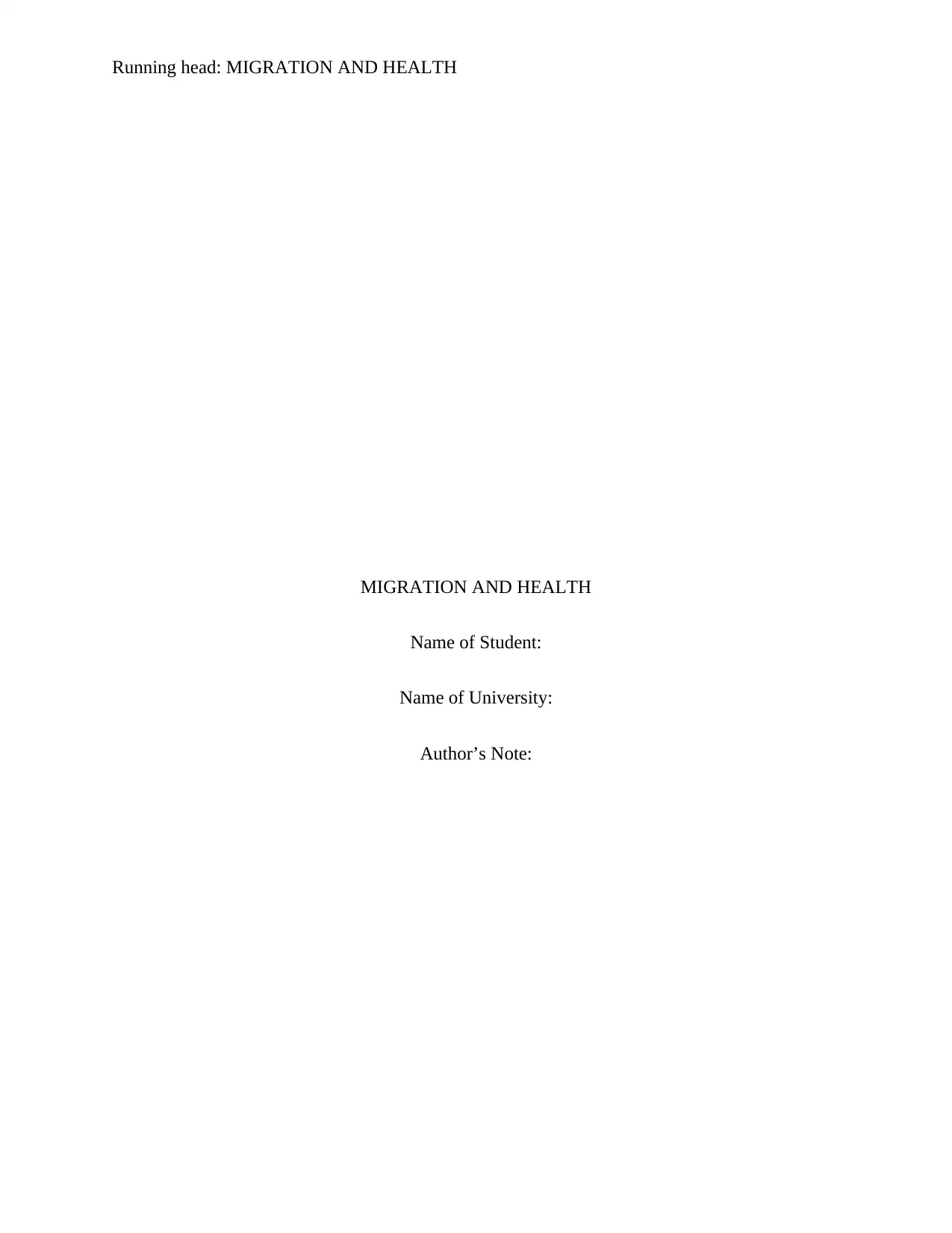
Running head: MIGRATION AND HEALTH
MIGRATION AND HEALTH
Name of Student:
Name of University:
Author’s Note:
MIGRATION AND HEALTH
Name of Student:
Name of University:
Author’s Note:
Paraphrase This Document
Need a fresh take? Get an instant paraphrase of this document with our AI Paraphraser
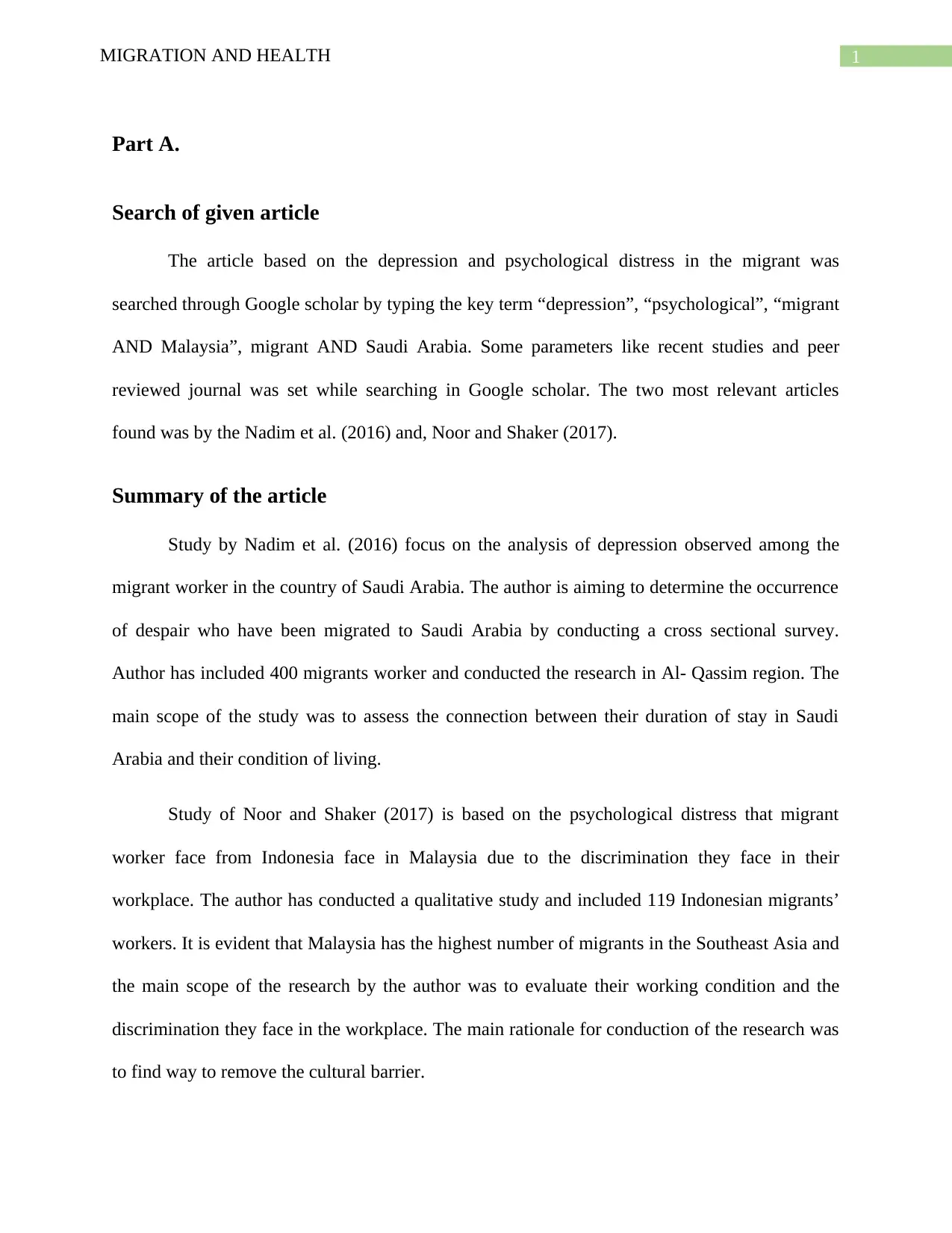
1MIGRATION AND HEALTH
Part A.
Search of given article
The article based on the depression and psychological distress in the migrant was
searched through Google scholar by typing the key term “depression”, “psychological”, “migrant
AND Malaysia”, migrant AND Saudi Arabia. Some parameters like recent studies and peer
reviewed journal was set while searching in Google scholar. The two most relevant articles
found was by the Nadim et al. (2016) and, Noor and Shaker (2017).
Summary of the article
Study by Nadim et al. (2016) focus on the analysis of depression observed among the
migrant worker in the country of Saudi Arabia. The author is aiming to determine the occurrence
of despair who have been migrated to Saudi Arabia by conducting a cross sectional survey.
Author has included 400 migrants worker and conducted the research in Al- Qassim region. The
main scope of the study was to assess the connection between their duration of stay in Saudi
Arabia and their condition of living.
Study of Noor and Shaker (2017) is based on the psychological distress that migrant
worker face from Indonesia face in Malaysia due to the discrimination they face in their
workplace. The author has conducted a qualitative study and included 119 Indonesian migrants’
workers. It is evident that Malaysia has the highest number of migrants in the Southeast Asia and
the main scope of the research by the author was to evaluate their working condition and the
discrimination they face in the workplace. The main rationale for conduction of the research was
to find way to remove the cultural barrier.
Part A.
Search of given article
The article based on the depression and psychological distress in the migrant was
searched through Google scholar by typing the key term “depression”, “psychological”, “migrant
AND Malaysia”, migrant AND Saudi Arabia. Some parameters like recent studies and peer
reviewed journal was set while searching in Google scholar. The two most relevant articles
found was by the Nadim et al. (2016) and, Noor and Shaker (2017).
Summary of the article
Study by Nadim et al. (2016) focus on the analysis of depression observed among the
migrant worker in the country of Saudi Arabia. The author is aiming to determine the occurrence
of despair who have been migrated to Saudi Arabia by conducting a cross sectional survey.
Author has included 400 migrants worker and conducted the research in Al- Qassim region. The
main scope of the study was to assess the connection between their duration of stay in Saudi
Arabia and their condition of living.
Study of Noor and Shaker (2017) is based on the psychological distress that migrant
worker face from Indonesia face in Malaysia due to the discrimination they face in their
workplace. The author has conducted a qualitative study and included 119 Indonesian migrants’
workers. It is evident that Malaysia has the highest number of migrants in the Southeast Asia and
the main scope of the research by the author was to evaluate their working condition and the
discrimination they face in the workplace. The main rationale for conduction of the research was
to find way to remove the cultural barrier.
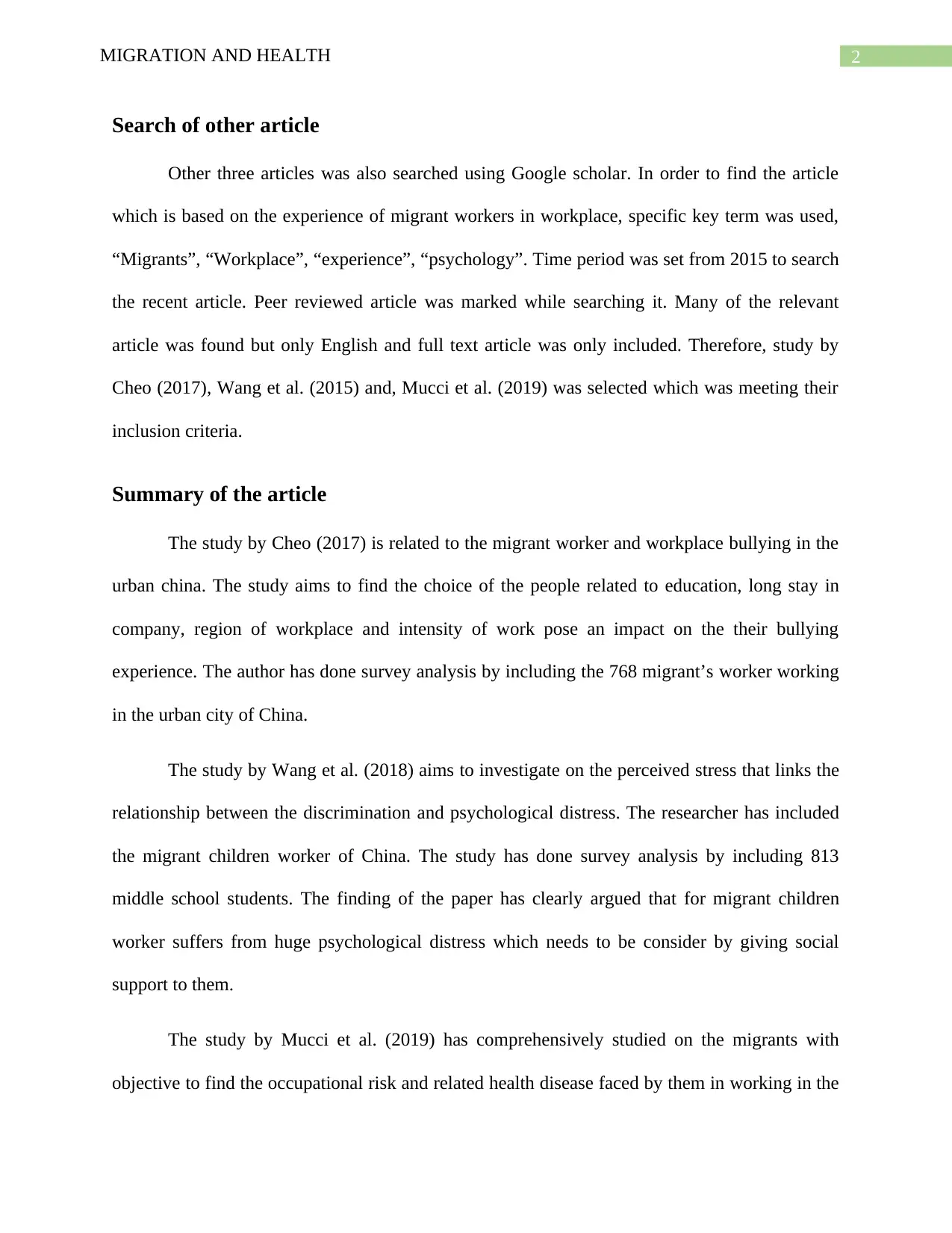
2MIGRATION AND HEALTH
Search of other article
Other three articles was also searched using Google scholar. In order to find the article
which is based on the experience of migrant workers in workplace, specific key term was used,
“Migrants”, “Workplace”, “experience”, “psychology”. Time period was set from 2015 to search
the recent article. Peer reviewed article was marked while searching it. Many of the relevant
article was found but only English and full text article was only included. Therefore, study by
Cheo (2017), Wang et al. (2015) and, Mucci et al. (2019) was selected which was meeting their
inclusion criteria.
Summary of the article
The study by Cheo (2017) is related to the migrant worker and workplace bullying in the
urban china. The study aims to find the choice of the people related to education, long stay in
company, region of workplace and intensity of work pose an impact on the their bullying
experience. The author has done survey analysis by including the 768 migrant’s worker working
in the urban city of China.
The study by Wang et al. (2018) aims to investigate on the perceived stress that links the
relationship between the discrimination and psychological distress. The researcher has included
the migrant children worker of China. The study has done survey analysis by including 813
middle school students. The finding of the paper has clearly argued that for migrant children
worker suffers from huge psychological distress which needs to be consider by giving social
support to them.
The study by Mucci et al. (2019) has comprehensively studied on the migrants with
objective to find the occupational risk and related health disease faced by them in working in the
Search of other article
Other three articles was also searched using Google scholar. In order to find the article
which is based on the experience of migrant workers in workplace, specific key term was used,
“Migrants”, “Workplace”, “experience”, “psychology”. Time period was set from 2015 to search
the recent article. Peer reviewed article was marked while searching it. Many of the relevant
article was found but only English and full text article was only included. Therefore, study by
Cheo (2017), Wang et al. (2015) and, Mucci et al. (2019) was selected which was meeting their
inclusion criteria.
Summary of the article
The study by Cheo (2017) is related to the migrant worker and workplace bullying in the
urban china. The study aims to find the choice of the people related to education, long stay in
company, region of workplace and intensity of work pose an impact on the their bullying
experience. The author has done survey analysis by including the 768 migrant’s worker working
in the urban city of China.
The study by Wang et al. (2018) aims to investigate on the perceived stress that links the
relationship between the discrimination and psychological distress. The researcher has included
the migrant children worker of China. The study has done survey analysis by including 813
middle school students. The finding of the paper has clearly argued that for migrant children
worker suffers from huge psychological distress which needs to be consider by giving social
support to them.
The study by Mucci et al. (2019) has comprehensively studied on the migrants with
objective to find the occupational risk and related health disease faced by them in working in the
⊘ This is a preview!⊘
Do you want full access?
Subscribe today to unlock all pages.

Trusted by 1+ million students worldwide
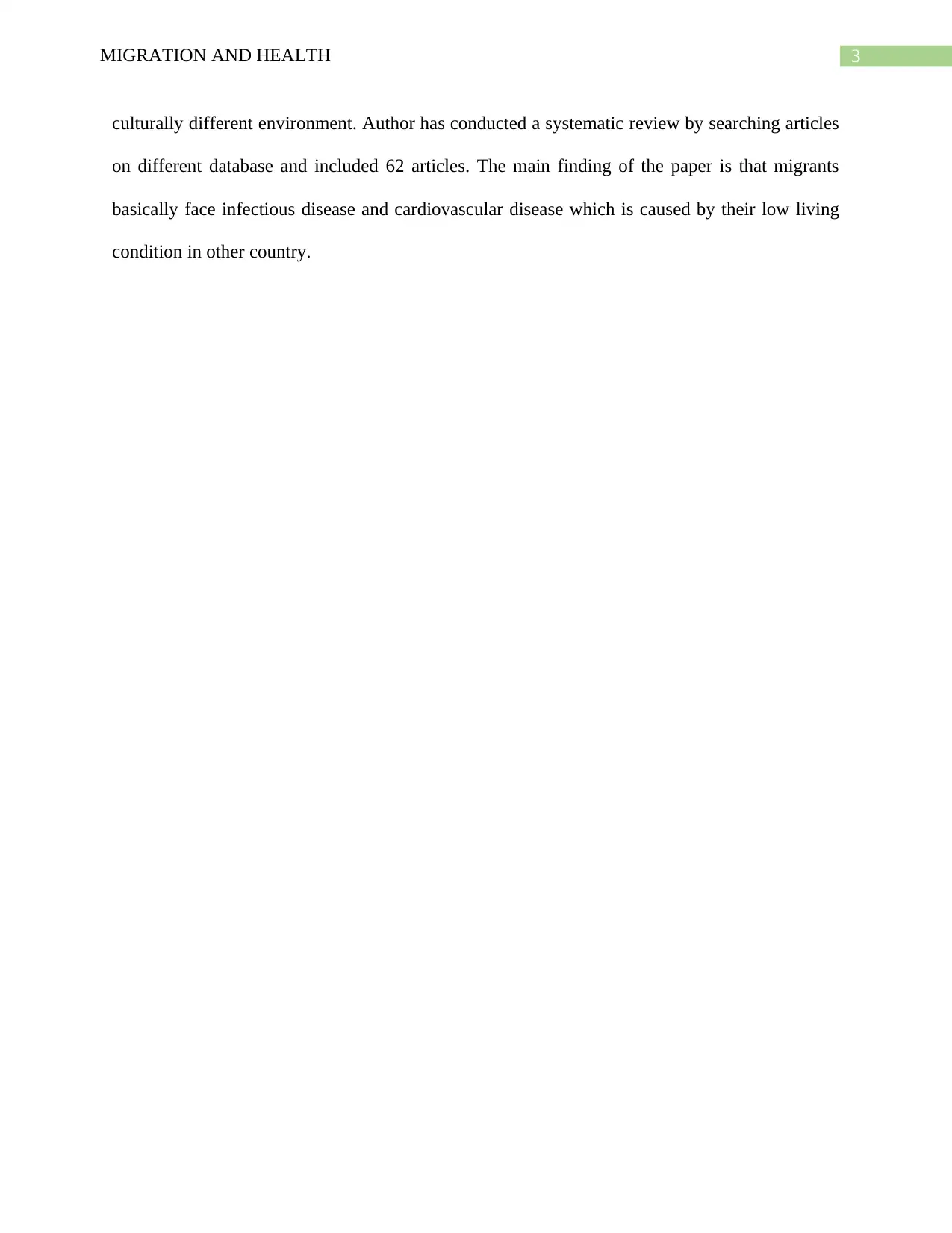
3MIGRATION AND HEALTH
culturally different environment. Author has conducted a systematic review by searching articles
on different database and included 62 articles. The main finding of the paper is that migrants
basically face infectious disease and cardiovascular disease which is caused by their low living
condition in other country.
culturally different environment. Author has conducted a systematic review by searching articles
on different database and included 62 articles. The main finding of the paper is that migrants
basically face infectious disease and cardiovascular disease which is caused by their low living
condition in other country.
Paraphrase This Document
Need a fresh take? Get an instant paraphrase of this document with our AI Paraphraser
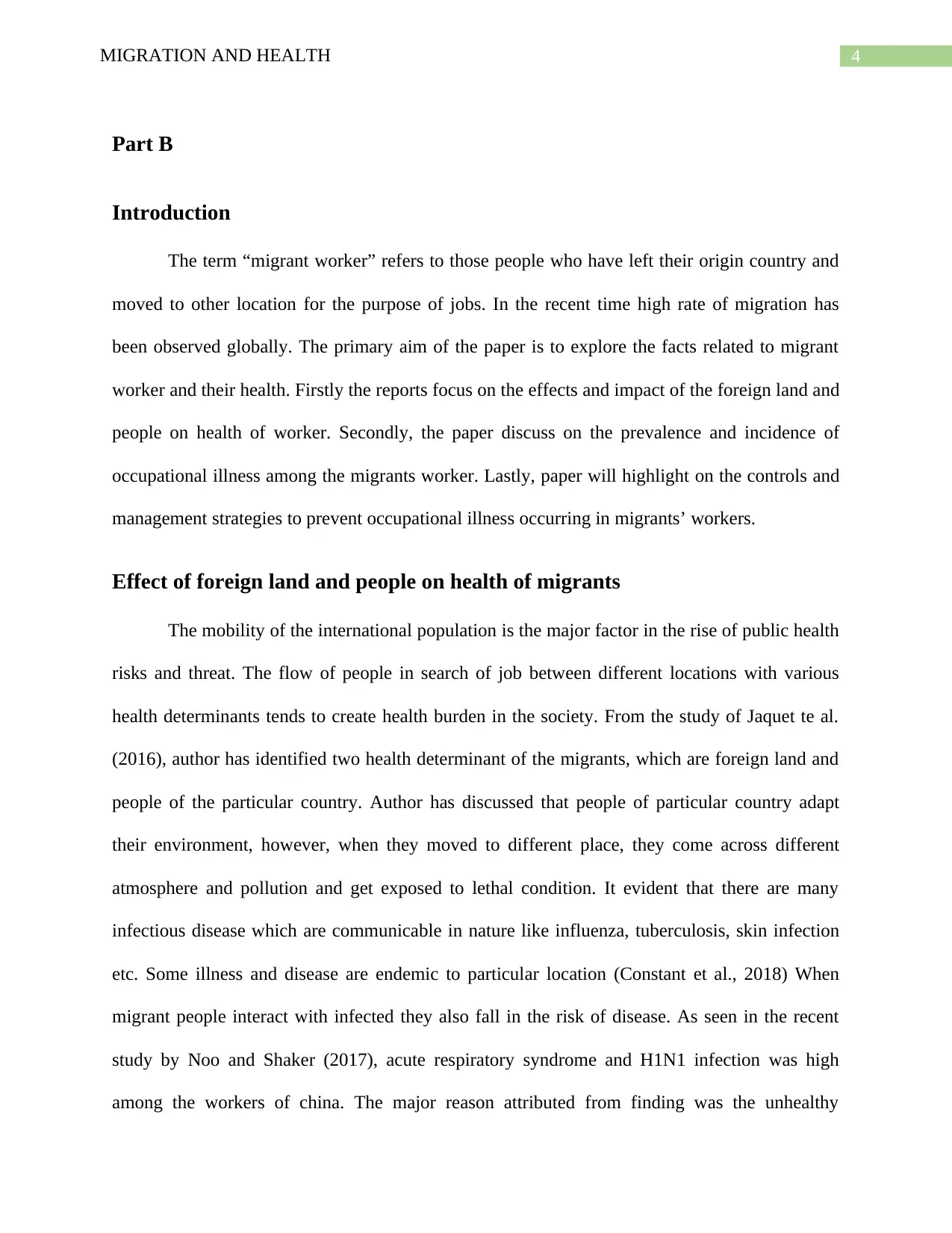
4MIGRATION AND HEALTH
Part B
Introduction
The term “migrant worker” refers to those people who have left their origin country and
moved to other location for the purpose of jobs. In the recent time high rate of migration has
been observed globally. The primary aim of the paper is to explore the facts related to migrant
worker and their health. Firstly the reports focus on the effects and impact of the foreign land and
people on health of worker. Secondly, the paper discuss on the prevalence and incidence of
occupational illness among the migrants worker. Lastly, paper will highlight on the controls and
management strategies to prevent occupational illness occurring in migrants’ workers.
Effect of foreign land and people on health of migrants
The mobility of the international population is the major factor in the rise of public health
risks and threat. The flow of people in search of job between different locations with various
health determinants tends to create health burden in the society. From the study of Jaquet te al.
(2016), author has identified two health determinant of the migrants, which are foreign land and
people of the particular country. Author has discussed that people of particular country adapt
their environment, however, when they moved to different place, they come across different
atmosphere and pollution and get exposed to lethal condition. It evident that there are many
infectious disease which are communicable in nature like influenza, tuberculosis, skin infection
etc. Some illness and disease are endemic to particular location (Constant et al., 2018) When
migrant people interact with infected they also fall in the risk of disease. As seen in the recent
study by Noo and Shaker (2017), acute respiratory syndrome and H1N1 infection was high
among the workers of china. The major reason attributed from finding was the unhealthy
Part B
Introduction
The term “migrant worker” refers to those people who have left their origin country and
moved to other location for the purpose of jobs. In the recent time high rate of migration has
been observed globally. The primary aim of the paper is to explore the facts related to migrant
worker and their health. Firstly the reports focus on the effects and impact of the foreign land and
people on health of worker. Secondly, the paper discuss on the prevalence and incidence of
occupational illness among the migrants worker. Lastly, paper will highlight on the controls and
management strategies to prevent occupational illness occurring in migrants’ workers.
Effect of foreign land and people on health of migrants
The mobility of the international population is the major factor in the rise of public health
risks and threat. The flow of people in search of job between different locations with various
health determinants tends to create health burden in the society. From the study of Jaquet te al.
(2016), author has identified two health determinant of the migrants, which are foreign land and
people of the particular country. Author has discussed that people of particular country adapt
their environment, however, when they moved to different place, they come across different
atmosphere and pollution and get exposed to lethal condition. It evident that there are many
infectious disease which are communicable in nature like influenza, tuberculosis, skin infection
etc. Some illness and disease are endemic to particular location (Constant et al., 2018) When
migrant people interact with infected they also fall in the risk of disease. As seen in the recent
study by Noo and Shaker (2017), acute respiratory syndrome and H1N1 infection was high
among the workers of china. The major reason attributed from finding was the unhealthy
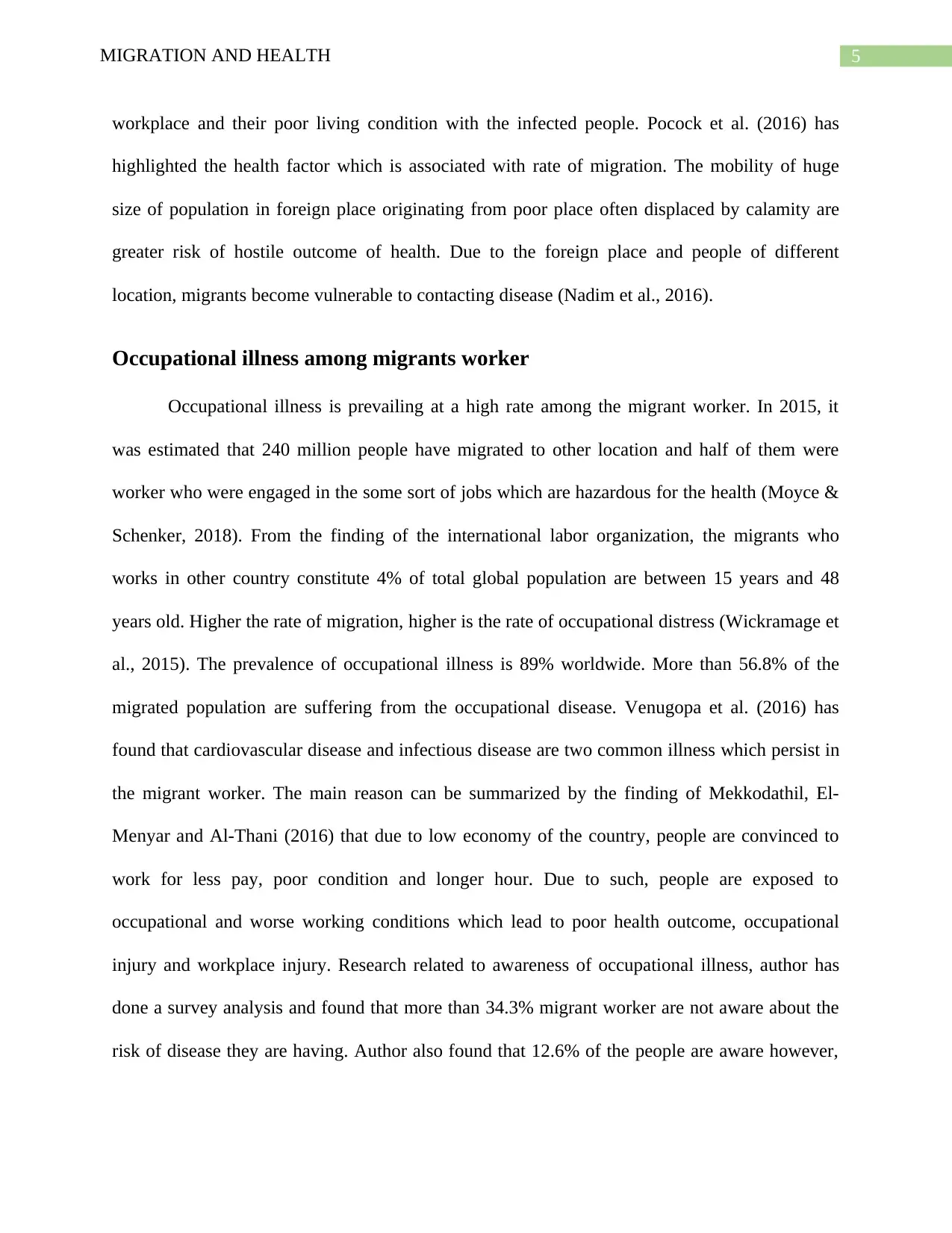
5MIGRATION AND HEALTH
workplace and their poor living condition with the infected people. Pocock et al. (2016) has
highlighted the health factor which is associated with rate of migration. The mobility of huge
size of population in foreign place originating from poor place often displaced by calamity are
greater risk of hostile outcome of health. Due to the foreign place and people of different
location, migrants become vulnerable to contacting disease (Nadim et al., 2016).
Occupational illness among migrants worker
Occupational illness is prevailing at a high rate among the migrant worker. In 2015, it
was estimated that 240 million people have migrated to other location and half of them were
worker who were engaged in the some sort of jobs which are hazardous for the health (Moyce &
Schenker, 2018). From the finding of the international labor organization, the migrants who
works in other country constitute 4% of total global population are between 15 years and 48
years old. Higher the rate of migration, higher is the rate of occupational distress (Wickramage et
al., 2015). The prevalence of occupational illness is 89% worldwide. More than 56.8% of the
migrated population are suffering from the occupational disease. Venugopa et al. (2016) has
found that cardiovascular disease and infectious disease are two common illness which persist in
the migrant worker. The main reason can be summarized by the finding of Mekkodathil, El-
Menyar and Al-Thani (2016) that due to low economy of the country, people are convinced to
work for less pay, poor condition and longer hour. Due to such, people are exposed to
occupational and worse working conditions which lead to poor health outcome, occupational
injury and workplace injury. Research related to awareness of occupational illness, author has
done a survey analysis and found that more than 34.3% migrant worker are not aware about the
risk of disease they are having. Author also found that 12.6% of the people are aware however,
workplace and their poor living condition with the infected people. Pocock et al. (2016) has
highlighted the health factor which is associated with rate of migration. The mobility of huge
size of population in foreign place originating from poor place often displaced by calamity are
greater risk of hostile outcome of health. Due to the foreign place and people of different
location, migrants become vulnerable to contacting disease (Nadim et al., 2016).
Occupational illness among migrants worker
Occupational illness is prevailing at a high rate among the migrant worker. In 2015, it
was estimated that 240 million people have migrated to other location and half of them were
worker who were engaged in the some sort of jobs which are hazardous for the health (Moyce &
Schenker, 2018). From the finding of the international labor organization, the migrants who
works in other country constitute 4% of total global population are between 15 years and 48
years old. Higher the rate of migration, higher is the rate of occupational distress (Wickramage et
al., 2015). The prevalence of occupational illness is 89% worldwide. More than 56.8% of the
migrated population are suffering from the occupational disease. Venugopa et al. (2016) has
found that cardiovascular disease and infectious disease are two common illness which persist in
the migrant worker. The main reason can be summarized by the finding of Mekkodathil, El-
Menyar and Al-Thani (2016) that due to low economy of the country, people are convinced to
work for less pay, poor condition and longer hour. Due to such, people are exposed to
occupational and worse working conditions which lead to poor health outcome, occupational
injury and workplace injury. Research related to awareness of occupational illness, author has
done a survey analysis and found that more than 34.3% migrant worker are not aware about the
risk of disease they are having. Author also found that 12.6% of the people are aware however,
⊘ This is a preview!⊘
Do you want full access?
Subscribe today to unlock all pages.

Trusted by 1+ million students worldwide
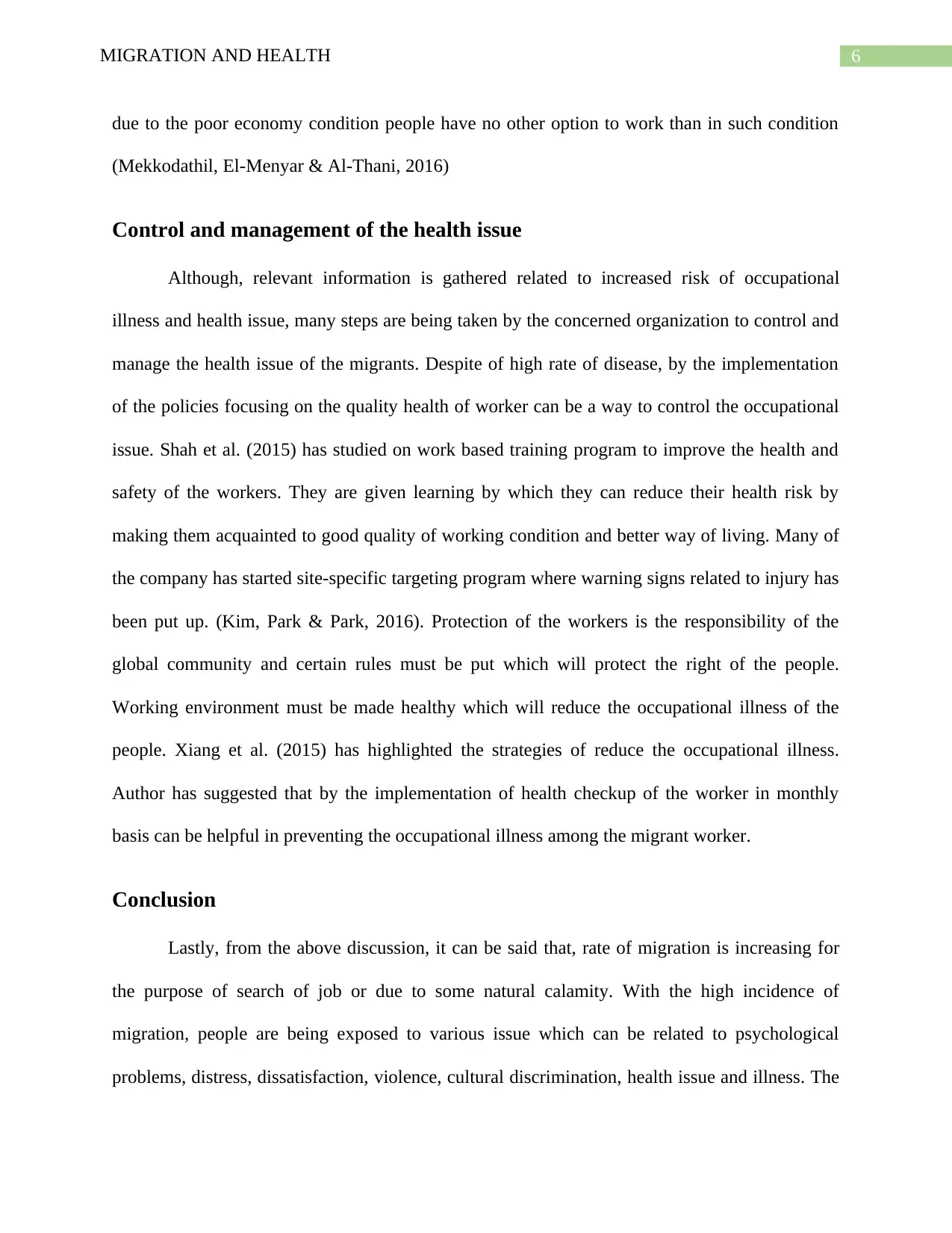
6MIGRATION AND HEALTH
due to the poor economy condition people have no other option to work than in such condition
(Mekkodathil, El-Menyar & Al-Thani, 2016)
Control and management of the health issue
Although, relevant information is gathered related to increased risk of occupational
illness and health issue, many steps are being taken by the concerned organization to control and
manage the health issue of the migrants. Despite of high rate of disease, by the implementation
of the policies focusing on the quality health of worker can be a way to control the occupational
issue. Shah et al. (2015) has studied on work based training program to improve the health and
safety of the workers. They are given learning by which they can reduce their health risk by
making them acquainted to good quality of working condition and better way of living. Many of
the company has started site-specific targeting program where warning signs related to injury has
been put up. (Kim, Park & Park, 2016). Protection of the workers is the responsibility of the
global community and certain rules must be put which will protect the right of the people.
Working environment must be made healthy which will reduce the occupational illness of the
people. Xiang et al. (2015) has highlighted the strategies of reduce the occupational illness.
Author has suggested that by the implementation of health checkup of the worker in monthly
basis can be helpful in preventing the occupational illness among the migrant worker.
Conclusion
Lastly, from the above discussion, it can be said that, rate of migration is increasing for
the purpose of search of job or due to some natural calamity. With the high incidence of
migration, people are being exposed to various issue which can be related to psychological
problems, distress, dissatisfaction, violence, cultural discrimination, health issue and illness. The
due to the poor economy condition people have no other option to work than in such condition
(Mekkodathil, El-Menyar & Al-Thani, 2016)
Control and management of the health issue
Although, relevant information is gathered related to increased risk of occupational
illness and health issue, many steps are being taken by the concerned organization to control and
manage the health issue of the migrants. Despite of high rate of disease, by the implementation
of the policies focusing on the quality health of worker can be a way to control the occupational
issue. Shah et al. (2015) has studied on work based training program to improve the health and
safety of the workers. They are given learning by which they can reduce their health risk by
making them acquainted to good quality of working condition and better way of living. Many of
the company has started site-specific targeting program where warning signs related to injury has
been put up. (Kim, Park & Park, 2016). Protection of the workers is the responsibility of the
global community and certain rules must be put which will protect the right of the people.
Working environment must be made healthy which will reduce the occupational illness of the
people. Xiang et al. (2015) has highlighted the strategies of reduce the occupational illness.
Author has suggested that by the implementation of health checkup of the worker in monthly
basis can be helpful in preventing the occupational illness among the migrant worker.
Conclusion
Lastly, from the above discussion, it can be said that, rate of migration is increasing for
the purpose of search of job or due to some natural calamity. With the high incidence of
migration, people are being exposed to various issue which can be related to psychological
problems, distress, dissatisfaction, violence, cultural discrimination, health issue and illness. The
Paraphrase This Document
Need a fresh take? Get an instant paraphrase of this document with our AI Paraphraser
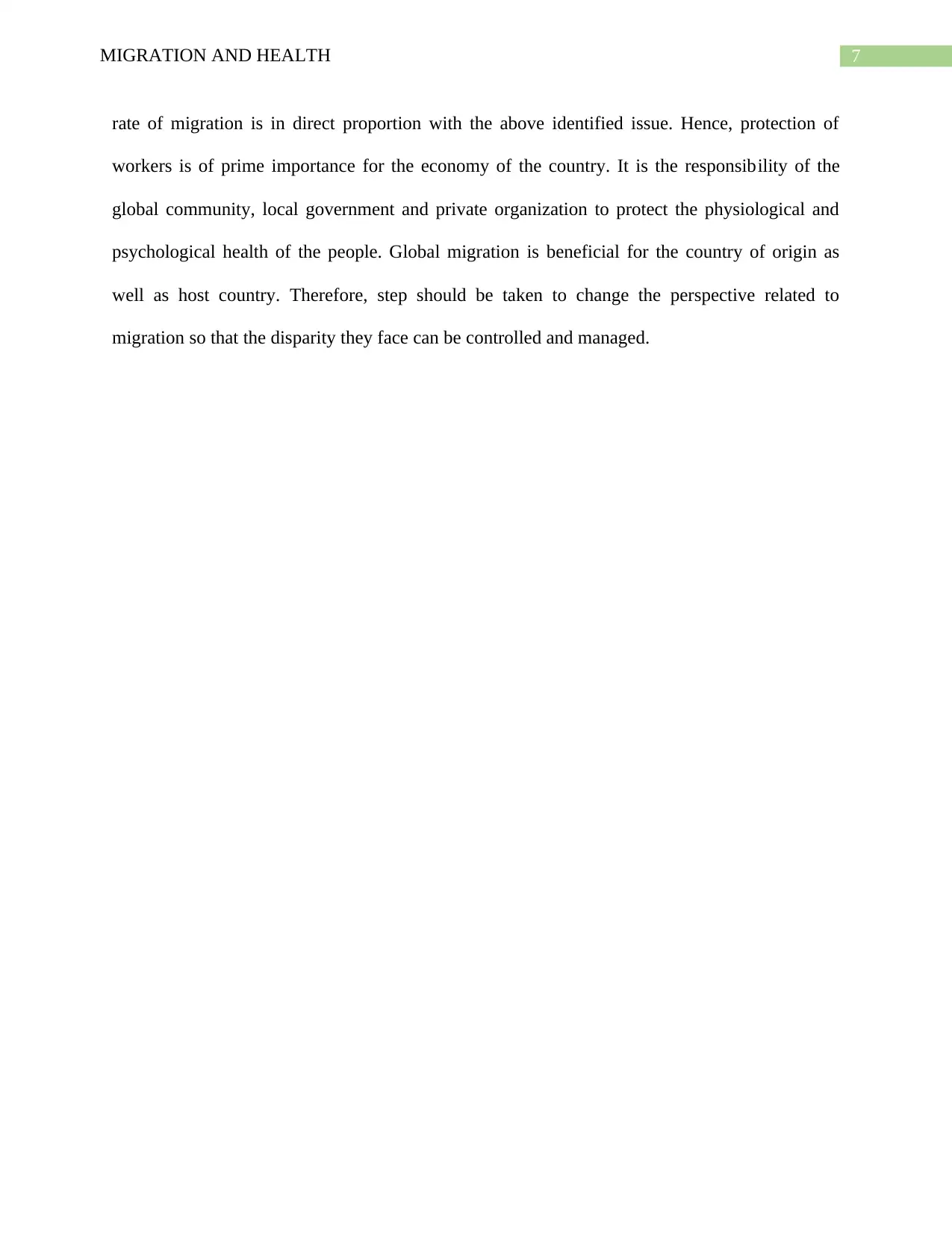
7MIGRATION AND HEALTH
rate of migration is in direct proportion with the above identified issue. Hence, protection of
workers is of prime importance for the economy of the country. It is the responsibility of the
global community, local government and private organization to protect the physiological and
psychological health of the people. Global migration is beneficial for the country of origin as
well as host country. Therefore, step should be taken to change the perspective related to
migration so that the disparity they face can be controlled and managed.
rate of migration is in direct proportion with the above identified issue. Hence, protection of
workers is of prime importance for the economy of the country. It is the responsibility of the
global community, local government and private organization to protect the physiological and
psychological health of the people. Global migration is beneficial for the country of origin as
well as host country. Therefore, step should be taken to change the perspective related to
migration so that the disparity they face can be controlled and managed.
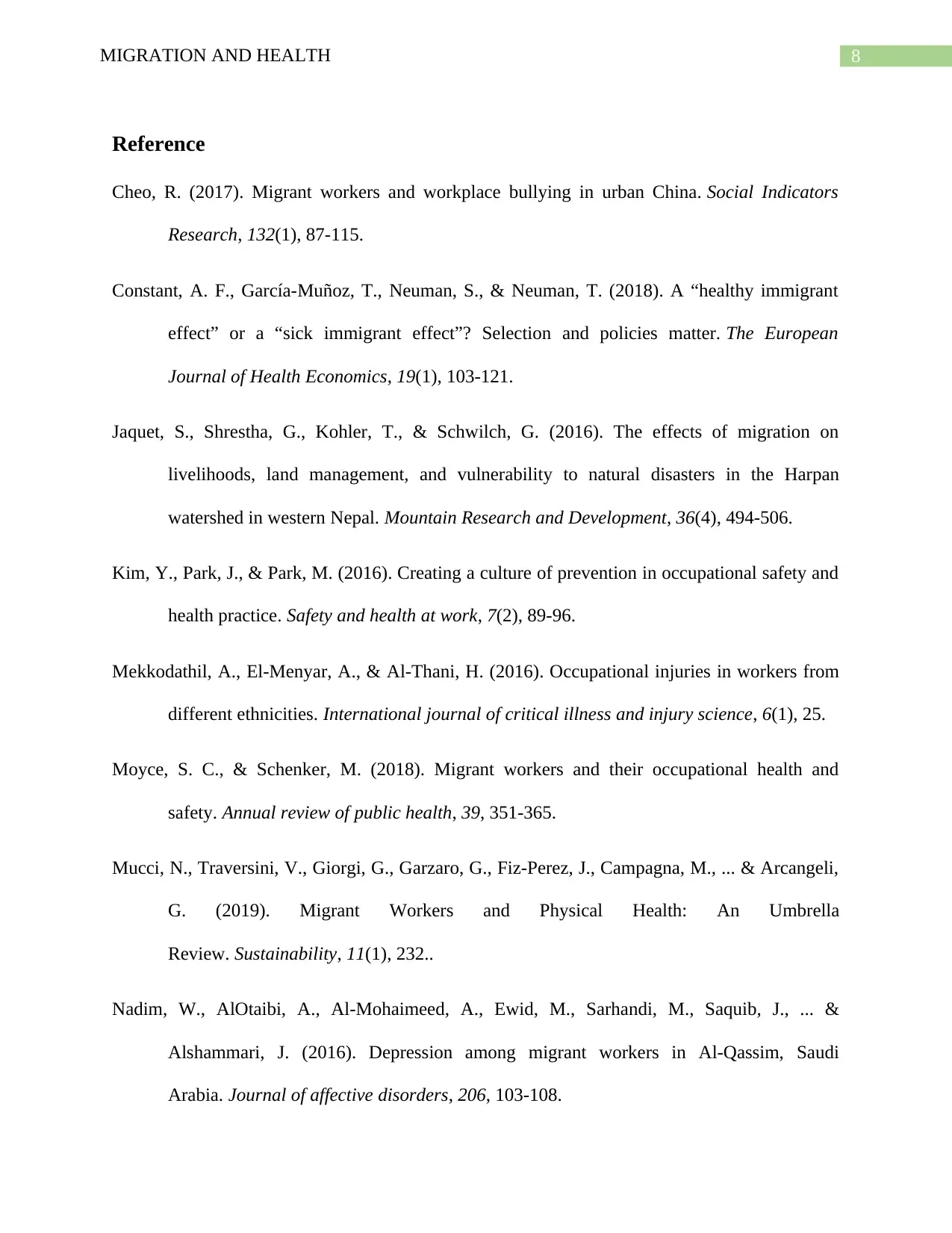
8MIGRATION AND HEALTH
Reference
Cheo, R. (2017). Migrant workers and workplace bullying in urban China. Social Indicators
Research, 132(1), 87-115.
Constant, A. F., García-Muñoz, T., Neuman, S., & Neuman, T. (2018). A “healthy immigrant
effect” or a “sick immigrant effect”? Selection and policies matter. The European
Journal of Health Economics, 19(1), 103-121.
Jaquet, S., Shrestha, G., Kohler, T., & Schwilch, G. (2016). The effects of migration on
livelihoods, land management, and vulnerability to natural disasters in the Harpan
watershed in western Nepal. Mountain Research and Development, 36(4), 494-506.
Kim, Y., Park, J., & Park, M. (2016). Creating a culture of prevention in occupational safety and
health practice. Safety and health at work, 7(2), 89-96.
Mekkodathil, A., El-Menyar, A., & Al-Thani, H. (2016). Occupational injuries in workers from
different ethnicities. International journal of critical illness and injury science, 6(1), 25.
Moyce, S. C., & Schenker, M. (2018). Migrant workers and their occupational health and
safety. Annual review of public health, 39, 351-365.
Mucci, N., Traversini, V., Giorgi, G., Garzaro, G., Fiz-Perez, J., Campagna, M., ... & Arcangeli,
G. (2019). Migrant Workers and Physical Health: An Umbrella
Review. Sustainability, 11(1), 232..
Nadim, W., AlOtaibi, A., Al-Mohaimeed, A., Ewid, M., Sarhandi, M., Saquib, J., ... &
Alshammari, J. (2016). Depression among migrant workers in Al-Qassim, Saudi
Arabia. Journal of affective disorders, 206, 103-108.
Reference
Cheo, R. (2017). Migrant workers and workplace bullying in urban China. Social Indicators
Research, 132(1), 87-115.
Constant, A. F., García-Muñoz, T., Neuman, S., & Neuman, T. (2018). A “healthy immigrant
effect” or a “sick immigrant effect”? Selection and policies matter. The European
Journal of Health Economics, 19(1), 103-121.
Jaquet, S., Shrestha, G., Kohler, T., & Schwilch, G. (2016). The effects of migration on
livelihoods, land management, and vulnerability to natural disasters in the Harpan
watershed in western Nepal. Mountain Research and Development, 36(4), 494-506.
Kim, Y., Park, J., & Park, M. (2016). Creating a culture of prevention in occupational safety and
health practice. Safety and health at work, 7(2), 89-96.
Mekkodathil, A., El-Menyar, A., & Al-Thani, H. (2016). Occupational injuries in workers from
different ethnicities. International journal of critical illness and injury science, 6(1), 25.
Moyce, S. C., & Schenker, M. (2018). Migrant workers and their occupational health and
safety. Annual review of public health, 39, 351-365.
Mucci, N., Traversini, V., Giorgi, G., Garzaro, G., Fiz-Perez, J., Campagna, M., ... & Arcangeli,
G. (2019). Migrant Workers and Physical Health: An Umbrella
Review. Sustainability, 11(1), 232..
Nadim, W., AlOtaibi, A., Al-Mohaimeed, A., Ewid, M., Sarhandi, M., Saquib, J., ... &
Alshammari, J. (2016). Depression among migrant workers in Al-Qassim, Saudi
Arabia. Journal of affective disorders, 206, 103-108.
⊘ This is a preview!⊘
Do you want full access?
Subscribe today to unlock all pages.

Trusted by 1+ million students worldwide
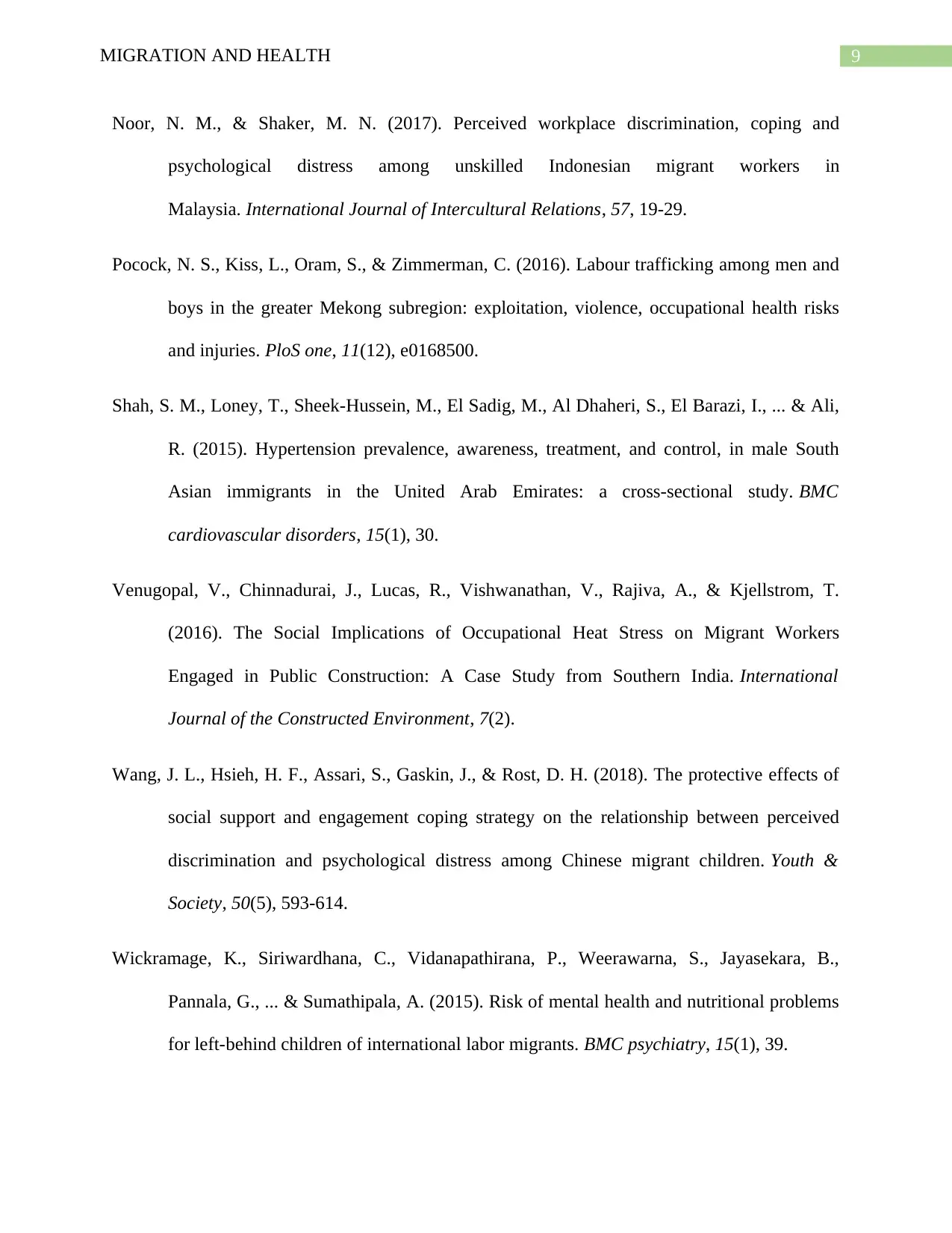
9MIGRATION AND HEALTH
Noor, N. M., & Shaker, M. N. (2017). Perceived workplace discrimination, coping and
psychological distress among unskilled Indonesian migrant workers in
Malaysia. International Journal of Intercultural Relations, 57, 19-29.
Pocock, N. S., Kiss, L., Oram, S., & Zimmerman, C. (2016). Labour trafficking among men and
boys in the greater Mekong subregion: exploitation, violence, occupational health risks
and injuries. PloS one, 11(12), e0168500.
Shah, S. M., Loney, T., Sheek-Hussein, M., El Sadig, M., Al Dhaheri, S., El Barazi, I., ... & Ali,
R. (2015). Hypertension prevalence, awareness, treatment, and control, in male South
Asian immigrants in the United Arab Emirates: a cross-sectional study. BMC
cardiovascular disorders, 15(1), 30.
Venugopal, V., Chinnadurai, J., Lucas, R., Vishwanathan, V., Rajiva, A., & Kjellstrom, T.
(2016). The Social Implications of Occupational Heat Stress on Migrant Workers
Engaged in Public Construction: A Case Study from Southern India. International
Journal of the Constructed Environment, 7(2).
Wang, J. L., Hsieh, H. F., Assari, S., Gaskin, J., & Rost, D. H. (2018). The protective effects of
social support and engagement coping strategy on the relationship between perceived
discrimination and psychological distress among Chinese migrant children. Youth &
Society, 50(5), 593-614.
Wickramage, K., Siriwardhana, C., Vidanapathirana, P., Weerawarna, S., Jayasekara, B.,
Pannala, G., ... & Sumathipala, A. (2015). Risk of mental health and nutritional problems
for left-behind children of international labor migrants. BMC psychiatry, 15(1), 39.
Noor, N. M., & Shaker, M. N. (2017). Perceived workplace discrimination, coping and
psychological distress among unskilled Indonesian migrant workers in
Malaysia. International Journal of Intercultural Relations, 57, 19-29.
Pocock, N. S., Kiss, L., Oram, S., & Zimmerman, C. (2016). Labour trafficking among men and
boys in the greater Mekong subregion: exploitation, violence, occupational health risks
and injuries. PloS one, 11(12), e0168500.
Shah, S. M., Loney, T., Sheek-Hussein, M., El Sadig, M., Al Dhaheri, S., El Barazi, I., ... & Ali,
R. (2015). Hypertension prevalence, awareness, treatment, and control, in male South
Asian immigrants in the United Arab Emirates: a cross-sectional study. BMC
cardiovascular disorders, 15(1), 30.
Venugopal, V., Chinnadurai, J., Lucas, R., Vishwanathan, V., Rajiva, A., & Kjellstrom, T.
(2016). The Social Implications of Occupational Heat Stress on Migrant Workers
Engaged in Public Construction: A Case Study from Southern India. International
Journal of the Constructed Environment, 7(2).
Wang, J. L., Hsieh, H. F., Assari, S., Gaskin, J., & Rost, D. H. (2018). The protective effects of
social support and engagement coping strategy on the relationship between perceived
discrimination and psychological distress among Chinese migrant children. Youth &
Society, 50(5), 593-614.
Wickramage, K., Siriwardhana, C., Vidanapathirana, P., Weerawarna, S., Jayasekara, B.,
Pannala, G., ... & Sumathipala, A. (2015). Risk of mental health and nutritional problems
for left-behind children of international labor migrants. BMC psychiatry, 15(1), 39.
Paraphrase This Document
Need a fresh take? Get an instant paraphrase of this document with our AI Paraphraser
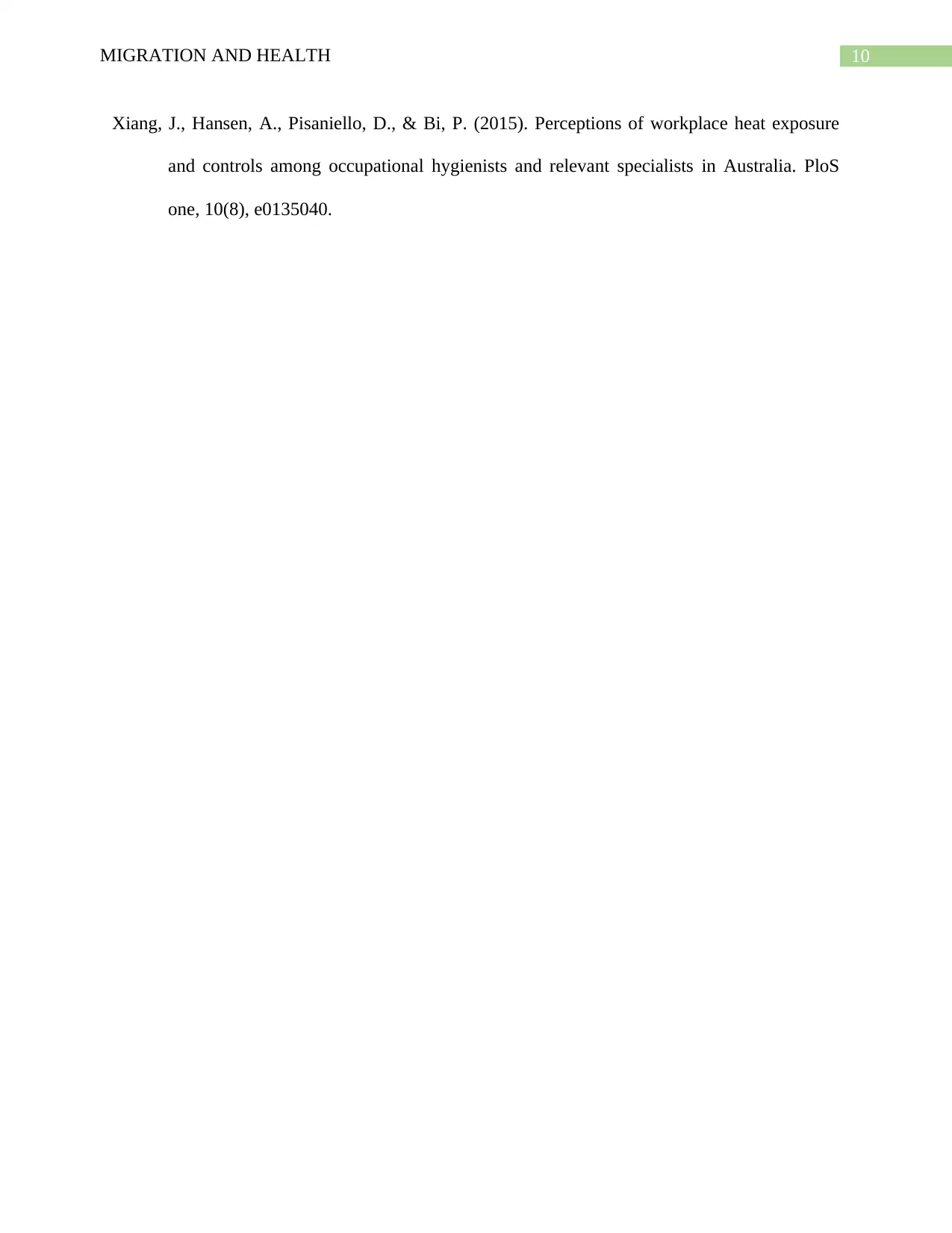
10MIGRATION AND HEALTH
Xiang, J., Hansen, A., Pisaniello, D., & Bi, P. (2015). Perceptions of workplace heat exposure
and controls among occupational hygienists and relevant specialists in Australia. PloS
one, 10(8), e0135040.
Xiang, J., Hansen, A., Pisaniello, D., & Bi, P. (2015). Perceptions of workplace heat exposure
and controls among occupational hygienists and relevant specialists in Australia. PloS
one, 10(8), e0135040.
1 out of 11
Your All-in-One AI-Powered Toolkit for Academic Success.
+13062052269
info@desklib.com
Available 24*7 on WhatsApp / Email
![[object Object]](/_next/static/media/star-bottom.7253800d.svg)
Unlock your academic potential
Copyright © 2020–2025 A2Z Services. All Rights Reserved. Developed and managed by ZUCOL.